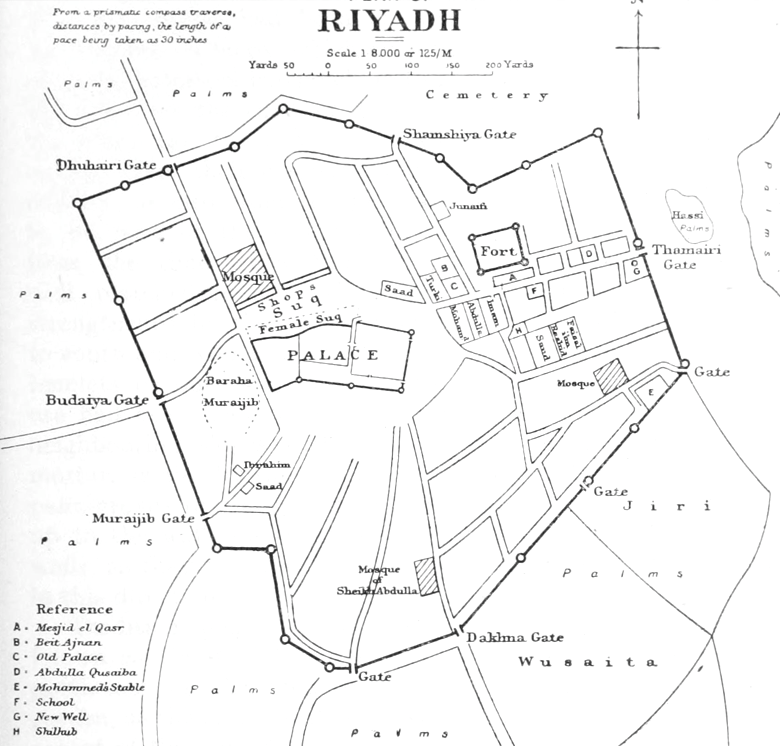|
Qaṣr 'Atīqa
Qaṣr 'Atīqa () was a fortified palace near Riyadh, Saudi Arabia. It was one of the earliest palaces erected outside the old town. The palace was built in 1922 and served as the residence of Muhammad bin Abdul Rahman Al Saud, a brother of King ʾAbd al-ʿAzīz Ibn Saud.H. St. J. B. Philby, ''Arabian Jubilee'' (London: Hale, 1952), plate facing 240. The building stood near Wadi Hanifa Wadi Hanifa (), historically known as Wadi al-Arad, is a ''wadi'' (seasonal river) in the Najd region, Riyadh Province, in central Saudi Arabia. The valley runs for a length of from northwest to southeast, cutting through the city of Riyadh, ..., not far from the current mosque of Muhammad bin Abdulrahman bin Faiṣal Al Saud. References Buildings and structures in Riyadh Government buildings completed in 1922 House of Saud Palaces in Saudi Arabia Royal residences in Saudi Arabia Demolished buildings and structures in Saudi Arabia {{SaudiArabia-struct-stub ... [...More Info...] [...Related Items...] OR: [Wikipedia] [Google] [Baidu] |
Riyadh
Riyadh is the capital and largest city of Saudi Arabia. It is also the capital of the Riyadh Province and the centre of the Riyadh Governorate. Located on the eastern bank of Wadi Hanifa, the current form of the metropolis largely emerged in the 1950s as an offshoot of the 18th century Walled town of Riyadh, walled town following the dismantling of its Riyadh city fortifications, defensive fortifications. It is the List of Arabian cities by population, largest city on the Arabian Peninsula, and is situated in the center of the An Nafud, an-Nafud desert, on the eastern part of the Najd plateau. The city sits at an average of above sea level, and receives around 5 million Tourism in Saudi Arabia, tourists each year, making it the List of cities by international visitors, forty-ninth most visited city in the world and the 6th in the Middle East. Riyadh had a population of 7.0 million people in 2022, making it the List of cities in Saudi Arabia, most-populous city in Saudi Arabia, ... [...More Info...] [...Related Items...] OR: [Wikipedia] [Google] [Baidu] |
Saudi Arabia
Saudi Arabia, officially the Kingdom of Saudi Arabia (KSA), is a country in West Asia. Located in the centre of the Middle East, it covers the bulk of the Arabian Peninsula and has a land area of about , making it the List of Asian countries by area, fifth-largest country in Asia, the largest in the Middle East, and the List of countries and dependencies by area, 12th-largest in the world. It is bordered by the Red Sea to the west; Jordan, Iraq, and Kuwait to the north; the Persian Gulf, Bahrain, Qatar and the United Arab Emirates to the east; Oman to the southeast; and Yemen to Saudi Arabia–Yemen border, the south. The Gulf of Aqaba in the northwest separates Saudi Arabia from Egypt and Israel. Saudi Arabia is the only country with a coastline along both the Red Sea and the Persian Gulf, and most of Geography of Saudi Arabia, its terrain consists of Arabian Desert, arid desert, lowland, steppe, and List of mountains in Saudi Arabia, mountains. The capital and List of cities ... [...More Info...] [...Related Items...] OR: [Wikipedia] [Google] [Baidu] |
Najdi Architecture
Najdi architecture () is a vernacular architecture indigenous to the Najd region of modern-day Saudi Arabia. The style flourished roughly between 13th and 18th centuries and is known for its desert adaptive urban patterns with low-contour earth-structured mudbrick buildings that are characterized by elements such as triangular or rectangular openings (''furjat'') and battlements (''shurfat'') as well as peepholes projecting outward from the main façade (''tarma''). The presence of a central courtyard and open spaces also forms a distinct part of the architectural style. The influence of Najdi style can be felt in neighboring regions, such as Architecture of Kuwait, Kuwait and inland Architecture of Qatar, Qatar. Construction method One of the most common types of construction in the Najd was the use of clay and mudbrick as well as other materials including stones, tamarisk and palm trees. Given the scarce availability of stones and different varieties of trees suitable for con ... [...More Info...] [...Related Items...] OR: [Wikipedia] [Google] [Baidu] |


